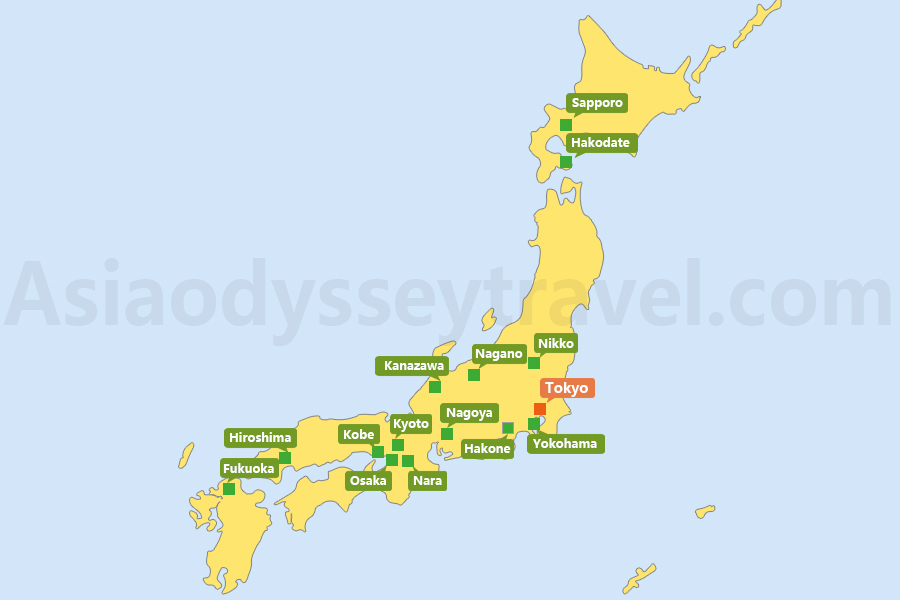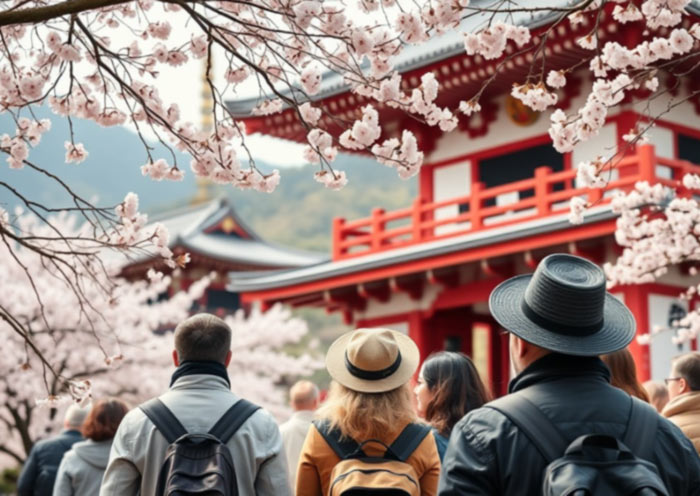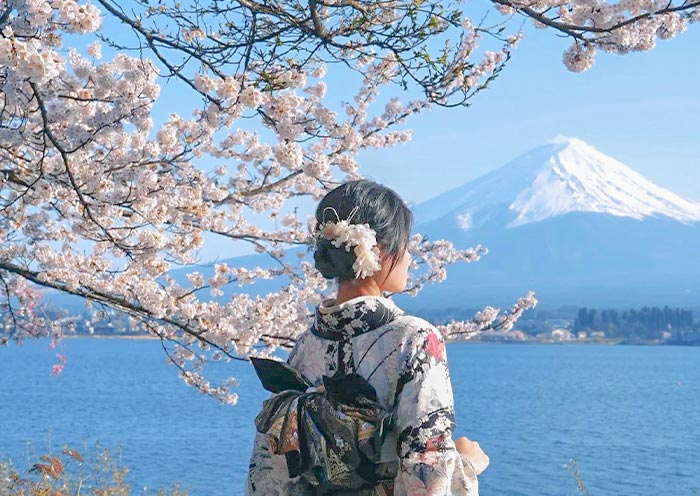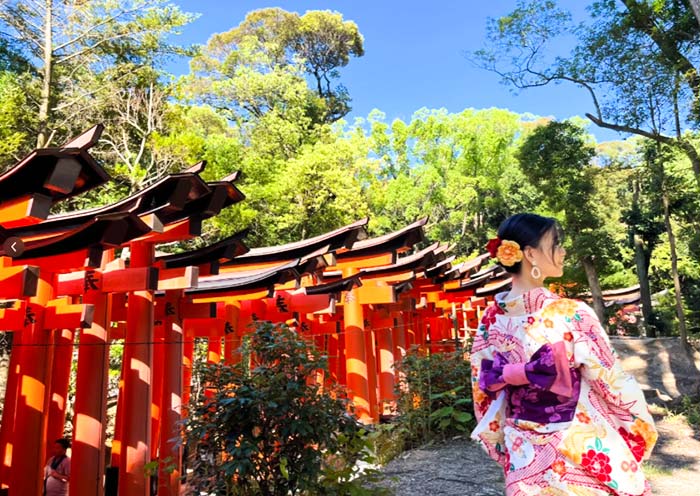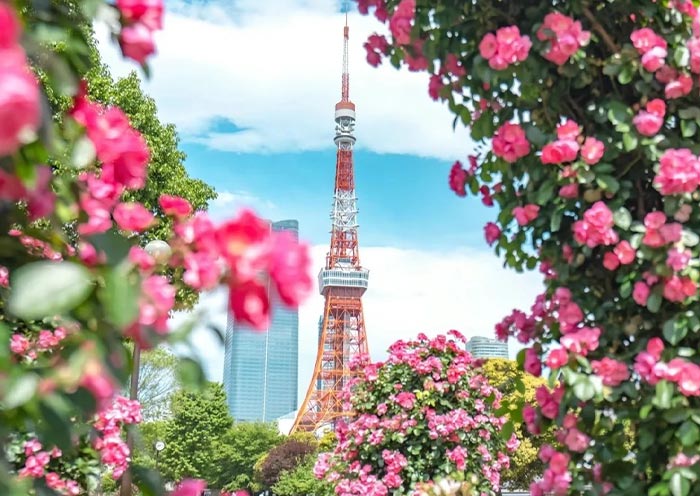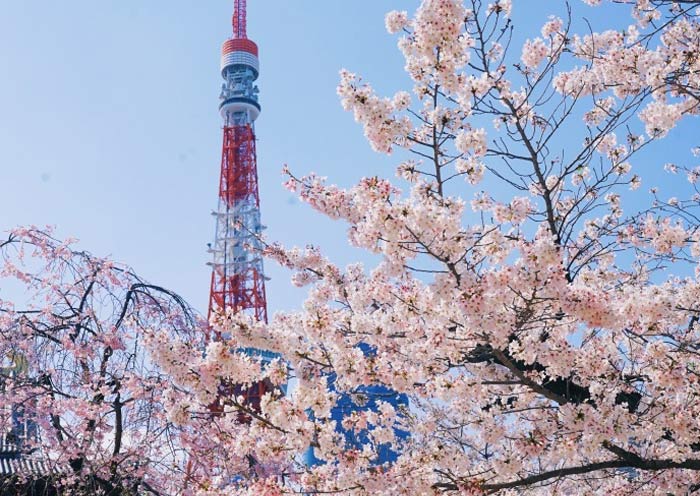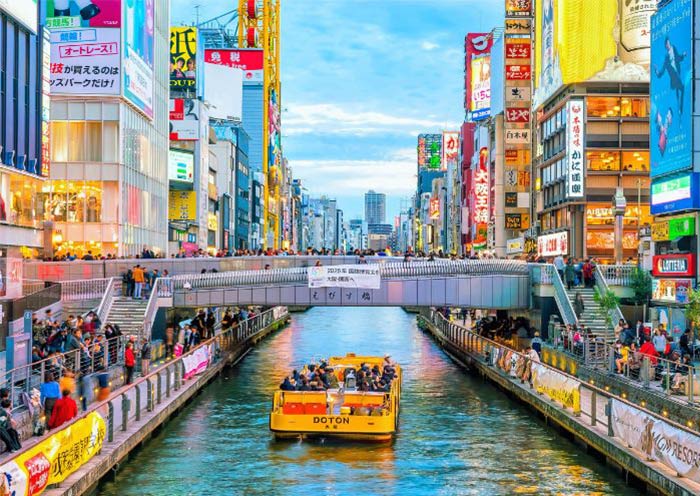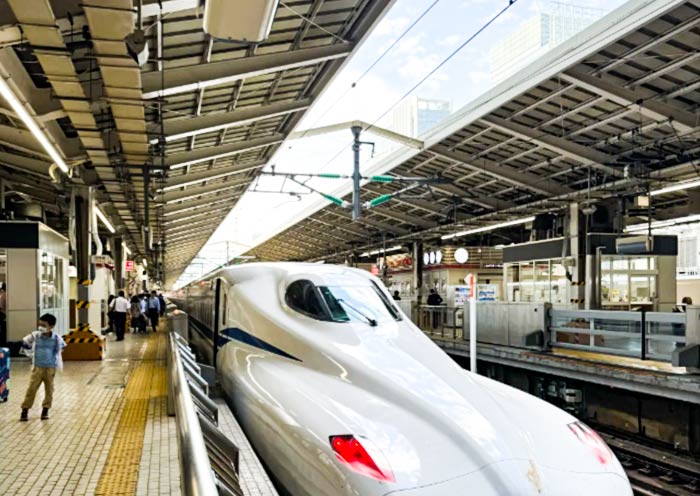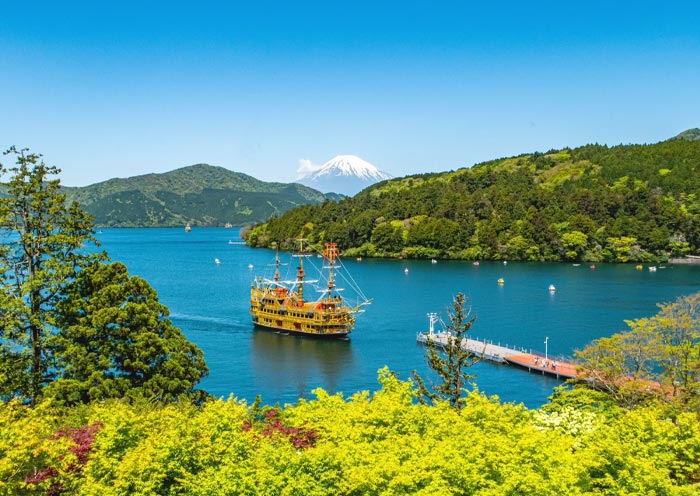Notable Differences Between Shrines & Temples in Japan
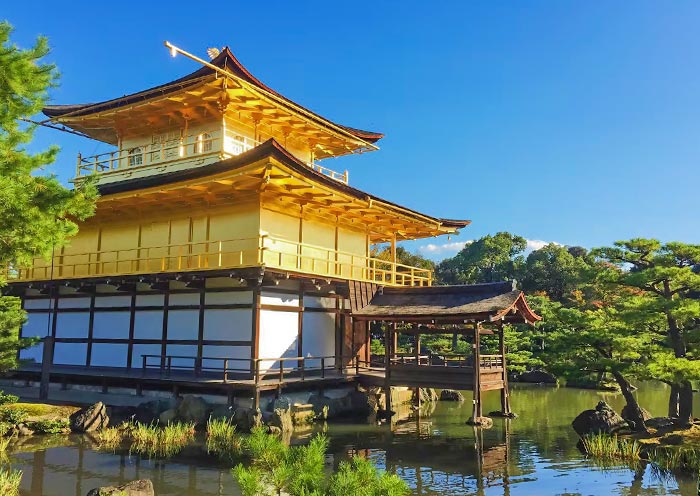
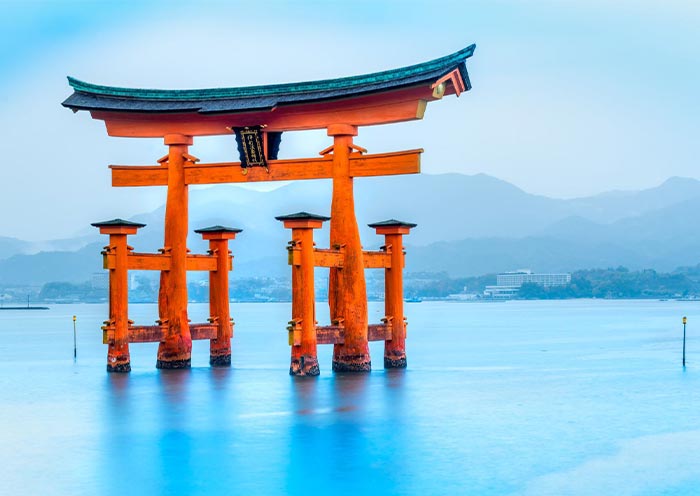
While both temples and shrines in Japan are places of religious significance, they serve distinct purposes and often have different architectural styles.
Temples in Japan are primarily associated with Buddhism and are used for worship, meditation, and spiritual practices.
Japanese Shrines, on the other hand, are more closely tied to Shintoism and are dedicated to honoring and appeasing kami, or spirits and deities.
These differences between Japanese Temples and Shrines are reflected in their architecture and overall atmosphere as well.
Easiest way to tell the different is look for the Torii Gate, the red wooden structure like in the picutre above, if there is a Torii Gate then it's shrine .
| Feature | Temples (寺, tera) | Shrines (神社, jinja) |
|---|---|---|
| Primary Religion | Buddhism | Shintoism (primarily) |
| Purpose | Worship, meditation, spiritual practices | Honoring and kami (spirits/deities) |
| Architecture | Pagodas, ornate gates (sanmon), Buddha statues | Torii gates, simple wooden buildings |
| Ambiance | Solemn, contemplative | Serene, natural |
Famous Temples & Shrines in Japan with Scenic Views
Japan's temples and shrines are renowned for their stunning natural beauty and scenic vistas. Japan's landscape provides a harmonious blend of architectural marvels with natural surroundings, creating picturesque settings that captivate visitors.
If you are a natural love who appreciate scenic views these famous temples in Japan are worth noticing: Kiyomizudera Temple in Kyoto is celebrated for its sweeping views over cherry and maple trees. Sanzen-in Temple offers a tranquil escape with its famous moss garden. Tenryuji Temple features a serene Zen garden that reflects seasonal beauty in Japan. Fushimi Inari-taisha enchant with their iconic vermilion torii gates. Kifune Shrine is known for its unique riverfront dining in Japan.
Each temple and shrine in Japan integrates seamlessly with its natural surroundings, enhancing the overall experience of Japan's rich cultural and natural heritage.
| Name | Specific Travel Highlights | Location |
|---|---|---|
| Kiyomizu-dera | Wooden stage offering stunning views, cherry blossom and autumn leaves; evening illuminations | Kyoto |
| Fushimi Inari-taisha | Thousands of vermilion torii gates; scenic hike, locally themed dishes | Kyoto |
| Itsukushima Shrine | Famous "floating" torii gate | Miyajima Island |
| Tenryu-ji | Known for Zen garden and seasonal scenic surrounding | Kyoto |
| Sanzen-in | Renowned for moss garden with stone statues | Kyoto |
| Kasuga Taisha | Known for picturesque lanterns tranquil pathways | Nara |
Kiyomizudera Temple (清水寺, Kyoto): Wooden Stage Offers Most Famous Scenic Views in Japan
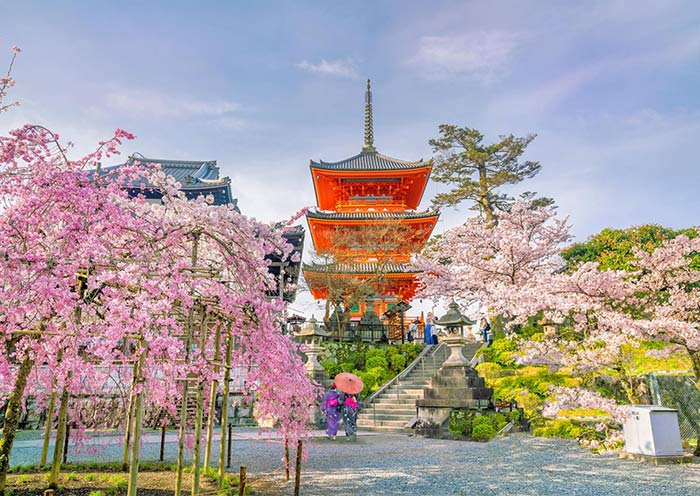
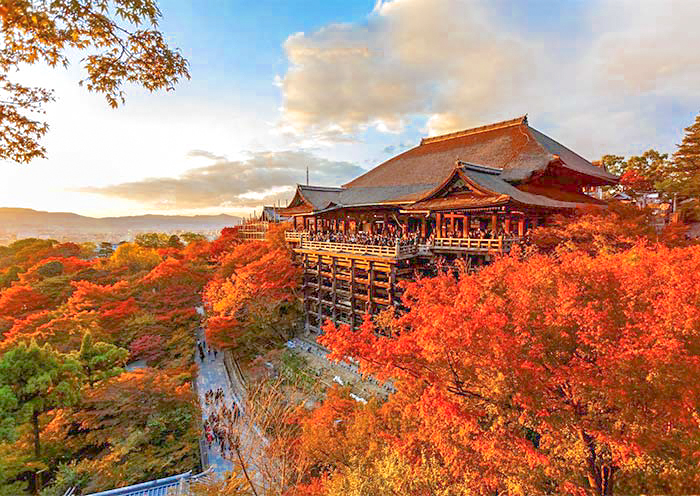
Kiyomizudera Temple Famous for:
- Wooden Stage with Best Views
- Cherry Blossom Season
- Autumn Leaves Sceptical
Kiyomizudera Temple, a renowned Buddhist temple in Kyoto, Japan, is renowned for its breathtaking natural beauty and scenic views, and is one of the most famous temples in Japan. The temple is dedicated to Kannon, the goddess of mercy, and has been a significant pilgrimage site for centuries.
The temple's most celebrated feature is its wooden stage, which extends 13 meters (42 feet) above the hillside. This stage offers panoramic views of Kyoto, especially during the >Cherry Blossom Season in late March and early April, and the autumn leaf season in November. The cherry and maple trees surrounding the temple create a stunning sea of color, making it a photographer's paradise.
Best Time To Visit Japan for Cherry Blossoms 2025 | Sakura Season in Japan
One of the most famous experiences at Kiyomizudera Temple is visiting during the special evening illuminations. These occur during the cherry blossom season, the autumn leaf season, and Obon in mid-August.
The temple and its surroundings are bathed in soft light, enhancing the magical atmosphere and offering a unique way to experience the beauty of the site with Japanese flair. Visitors can also explore the various sub-temples and the Otowa Waterfall, which is believed to have wish-granting powers.
Fushimi Inari-taisha Shrine (伏見稲荷大社, Kyoto): Most Visited Shrine in Japan with Thousand Torii Gates
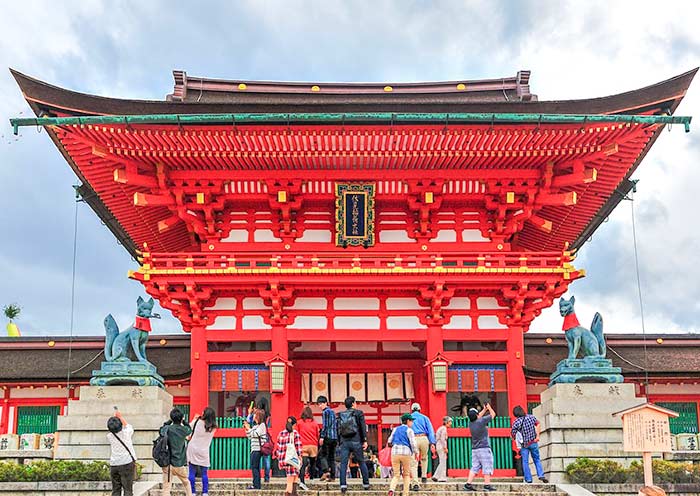
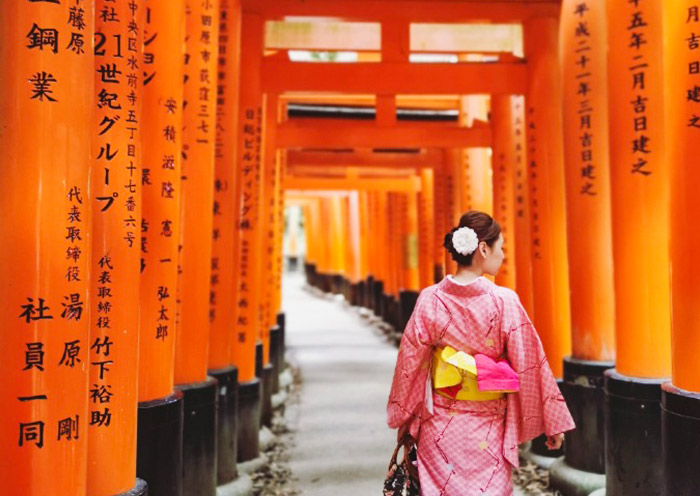
Shrine Famous for:
- Thousands Torii Gate
- Fun Hike from the Shrine to Mount Inari
- Famous Udon Noodle Honoring Fox, Messenger of Gods
Fushimi Inari-taisha Shrine (伏見稲荷大社) is one of Japan's most famous and visited shrines, located in Kyoto. This sacred Japanese shrine is dedicated to Inari, the Shinto god of rice, agriculture, and business prosperity. The shrine is especially revered for its connection to foxes, believed to be Inari's messengers.
Fushimi Inari-taisha shrine is renowned for its natural beauty and the scenic views it offers. The shrine's most famous feature is the Senbon Torii, or "thousands of torii gates," which form vibrant vermilion tunnels winding through the dense forest of Mount Inari. These gates, donated by worshippers, create a mesmerizing pathway that leads visitors on a spiritual journey to the mountain's summit.
A visit to Fushimi Inari-taisha is an unforgettable experience, particularly for those who embark on the hike to the summit of Mount Inari. Along the way, visitors can enjoy breathtaking views of Kyoto and stop at various smaller Japanese shrines nestled in the forest.
Kyoto Itinerary: How to Spend 1 Day, 2 Days, 3 Days, 4 Days in Kyoto
The hike from the shrine is also an opportunity to savor Japanese local delicacies like Inari Sushi and Kitsune Udon ("Fox Udon"), both featuring aburaage (fried tofu), which is said to be a favorite food of foxes, in local belief foxes serve as messenger for Inari God. And of course it is also a famous unique dish in Japan that can be enjoyed by human.
Itsukushima Shrine (嚴島神社, Miyajima Island): Celestial Shrine Floating on Water, Enshrines The Goddess of the Sea
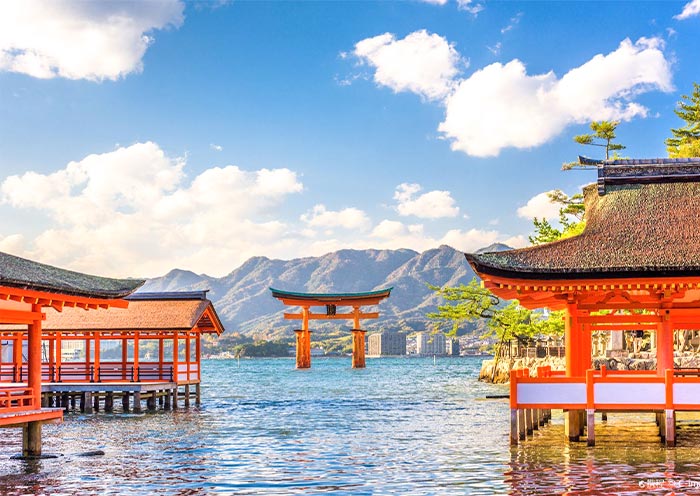
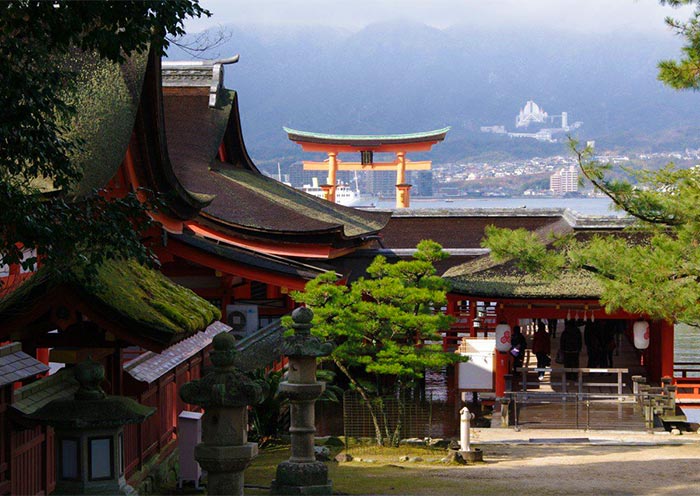
Itsukushima Shrine Famous for:
- Shrine Built on Water
- Torii at coast Gate looks like floating on Water
Itsukushima Shrine (嚴島神社) is one of Japan's most iconic and picturesque shrines, located on Miyajima Island, just off the coast of Hiroshima.
This Shinto shrine is dedicated to the deities of sea and storm, including the goddess of the seas, Ichikishimahime-no-Mikoto. The shrine has a history that dates back to the 6th century and is deeply intertwined with Japan's spiritual heritage.
The shrine is world-renowned for its natural beauty, particularly its "floating" torii gate. At high tide, this massive vermilion gate appears to float on the water, creating a breathtaking scene that has become one of Japan's most famous photographed views. The shrine itself is built over the water, supported by stilts, enhancing its ethereal beauty, especially during sunrise and sunset.
Most Beautiful Places in Japan | Top 15 Places to Visit in Japan
The best way to admire the shrine and its celebrated torii gate is to take a cruise so you can see the beautiful floating shrine and torii gate from ocean. Visitors to Itsukushima Shrine can also enjoy a unique experience by exploring the island's scenic trails, especially the scenic spot at Yotsutsuji intersection, from where you can enjoy panoramic views over the island and the surrounding Seto Inland Sea.
Tenryuji Temple (天龍寺, Kyoto): Prominent Zen Garden Beloved by Everyone in Japan
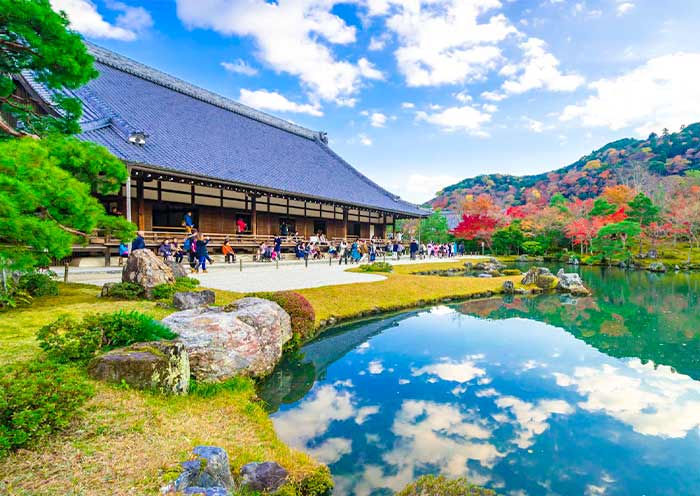
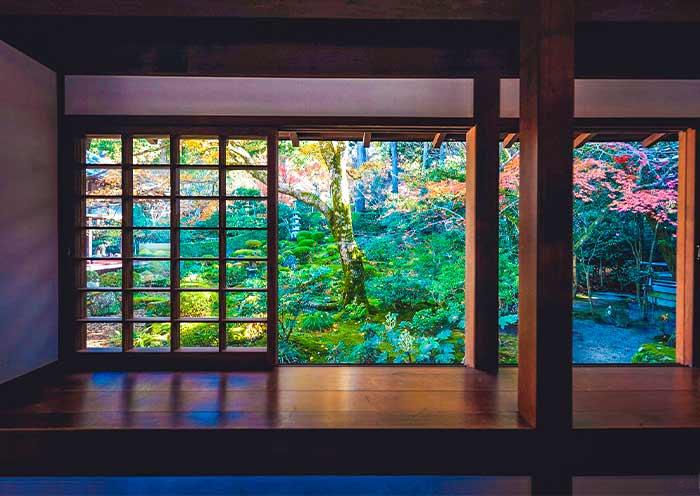
Tenryuji Temple Famous for:
- Zen Garden by Muso Soseki
- Cherry Blossom & Autumn Leaves Views with Exquisite Garden
Tenryuji Temple (天龍寺) is a renowned Zen Buddhist temple located in the Arashiyama district of Kyoto. As the head temple of the Tenryu branch of Rinzai Zen Buddhism, it is dedicated to the bodhisattva Avalokiteshvara, also known as Kannon. Established in 1339, the temple has a rich history and has been designated as a UNESCO World Heritage Site.
Tenryuji Temple is particularly famous for its exquisite Zen garden which really stands out among the temples and shrines in Japan. Designed by the celebrated garden designer Muso Soseki, the temple's landscape garden is a masterpiece of Japanese garden design.
The Japanese Garden at the Temple features a tranquil central pond surrounded by carefully placed rocks, pine trees, and the lush, forested Arashiyama mountains in the background. The scenery changes with the seasons, offering stunning views throughout the year-cherry blossoms in spring, vibrant foliage in autumn, and serene snow-covered landscapes in winter.
Best Time to Visit Japan & Worst Time to Visit Japan
Pay a visit to Tenryuji Temple where you can stroll through the garden, taking in the harmony between the natural elements and the meticulously arranged surroundings. The temple also offers a chance to experience the meditative ambiance of Zen Buddhism, making it a must-visit Temple for those seeking both beauty and tranquility in Kyoto.
Sanzen-in Temple (三千院, Kyoto): Buddha Statues Amidst Lush Carpet of Green Moss, Classic Japanese Aesthetics
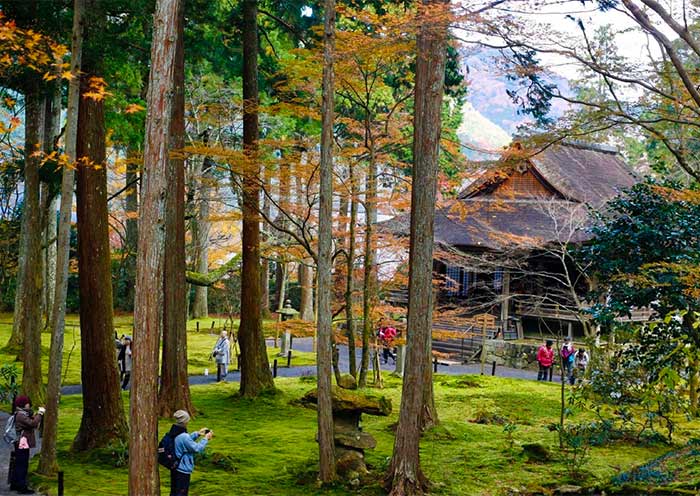

Temple Famous for:
- Childlike Buddha Statues among Lush Moss
- Japanese calligraphy and paintings
Sanzen-in Temple (三千院) is a serene also famous Buddhist temple located in the picturesque village of Ohara, north of Kyoto. This temple is dedicated to the Amida Buddha and is a prominent site for those seeking tranquility and natural beauty which can be hard to come by in high season in Japan's famous temples.
Sanzen-in is particularly renowned for its famous moss garden, which is adorned with charming stone statues known as "warabe jizo" (childlike Buddha statues). These statues of Sanzen-in Temple, nestled among the soft, green moss, create a peaceful and almost mystical atmosphere that invites quiet reflection.
When visiting Sanzen-in Temple you can begin your exploration at the Kyakuden, or guest hall, where you can admire exquisite works of Japanese calligraphy and paintings on the sliding doors (fusuma). The Kyakuden opens onto the Shuhekien Garden, a traditional Japanese garden featuring a small pond and a hill, perfectly embodying the harmonious balance of nature and art.
A visit to Sanzen-in offers a deeply calming experience, allowing tourists to immerse themselves in the beauty of the temple's gardens and the spiritual ambiance of this sacred site. It's a must-visit temple for those looking to escape the hustle and bustle of city life and connect with nature in a spiritual settings in Japan.
Shrines & Temples in Japan Famous for Cultural and Historical Value
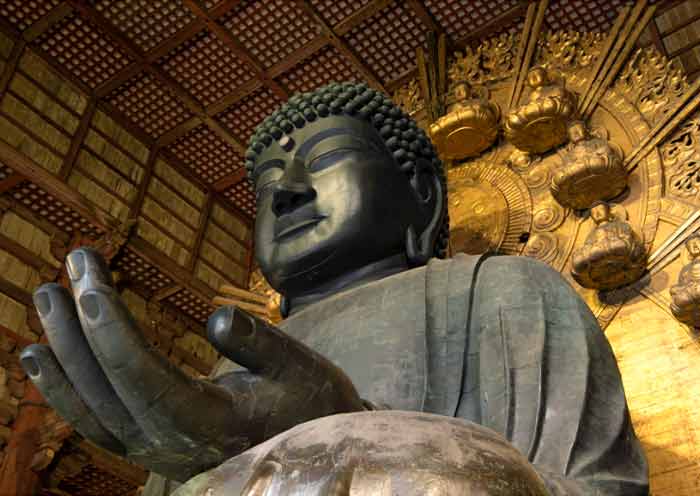
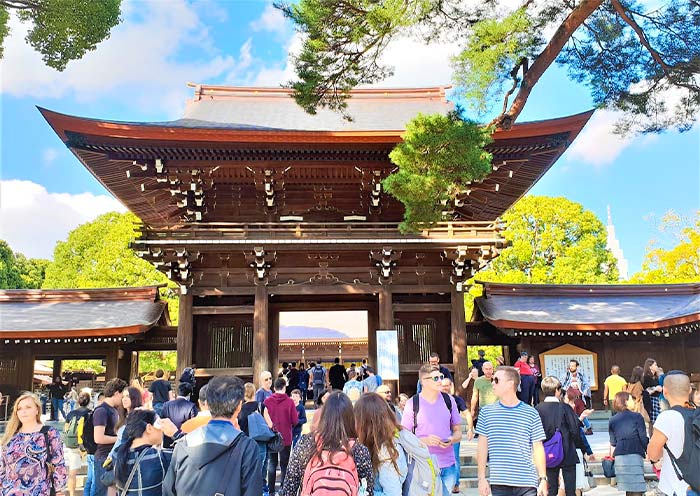
Japan's temples and shrines are deeply intertwined with the country's cultural and historical tapestry, offering visitors a profound glimpse into its past.
Here are some of the iconic famous temples and shrines in Japan with culture & historical value:
- Senso-ji Temple reflects the historical significance and the rich traditions of Tokyo.
- Todaiji Temple is renowned for its Great Buddha.
- Kasuga Taisha Shrine, associated with the influential Fujiwara clan, showcases traditional Shinto practices and historical artifacts.
- Nikko Toshogu Shrine, dedicated to Tokugawa Ieyasu, stands as a prominent memorial to the famous founder of the Tokugawa Shogunate.
- Meiji Jingu Shrine in Tokyo symbolizes the Meiji Restoration.
- Byodoin Temple in Uji is celebrated for its Phoenix Hall, a masterpiece of Heian-period architecture.
| Name | Specific Travel Highlights | Location |
|---|---|---|
| Senso-ji Temple | Tokyo's oldest temple, Kaminarimon (Thunder Gate), vibrant Street | Asakusa, Tokyo |
| Todaiji Temple | Great Buddha Statue, spacious grounds, roaming deer | Nara, Nara Prefecture |
| Kasuga Taisha Shrine | Linked to Fujiwara clan, famous Lantern pathways, Kasuga Taisha Museum | Nara, Nara Prefecture |
| Nikko Toshogu Shrine | Blends Shinto and Buddhist elements, Personal artifacts of Shogun | Nikko, Tochigi Prefecture |
| Meiji Jingu Shrine | Dedicated to Emperor Meiji, traditional Shinto activities | Tokyo, Harajuku |
| Yasaka Shrine | Central to the Gion festival; cherry blossom | Kyoto |
Senso-ji Temple (浅草寺, Tokyo): Living History, Cultural Icon, Community Centre in Tokyo
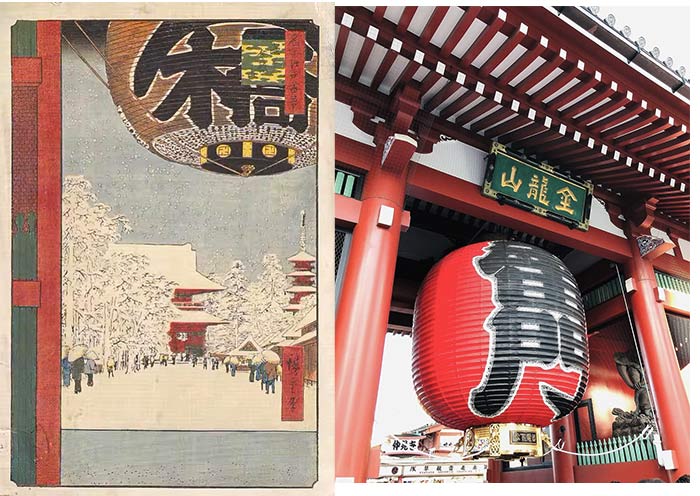
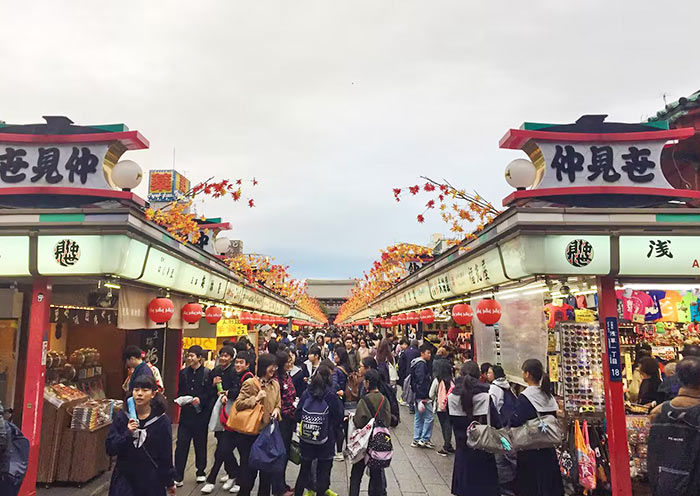
Senso-ji Temple Famous for:
- Colorful Landmark Gate
- Vibrant Community Centre
Senso-ji Temple (浅草寺) is Tokyo's oldest and most revered temple, also a beloved past-time spot for locals, located in the vibrant Asakusa district. This famous iconic Buddhist temple is dedicated to Kannon, the goddess of mercy, and holds profound cultural and historical significance for Japan.
As a living testament to Tokyo's rich history, Senso-ji is a perfect temple to visit for anyone interested in experiencing the cultural heritage of Japan. The temple's deep roots date back to the year 645, and it has since become a symbol of community spirit in Tokyo. Senso-ji temple is also known as one of the city's most colorful and popular temples, attracting millions of visitors each year to Japan.
The journey to Senso-ji begins at Kaminarimon, or the Thunder Gate, which serves as the grand entrance to the temple complex. This gate, with its massive red lantern and fearsome guardian statues, is not only the symbol of Asakusa but also one of the most famous landmarks in Tokyo. Beyond the gate, visitors can stroll down Nakamise Street, a bustling shopping street lined with traditional shops and stalls offering souvenirs, snacks, and local delicacies.
Tokyo Tourist Attractions | Things to Do & Places to Visit in Tokyo
Visiting Senso-ji Temple is a meaningful immersion into Tokyo's living history, where tradition and modernity coexist, making it a cultural icon and a center of community life in the heart of Tokyo, and a perfect icon for Japan.
Todaiji Temple (東大寺, Nara): Biggest Wooden Architecture Housing Biggest Bronze Buddha Statue
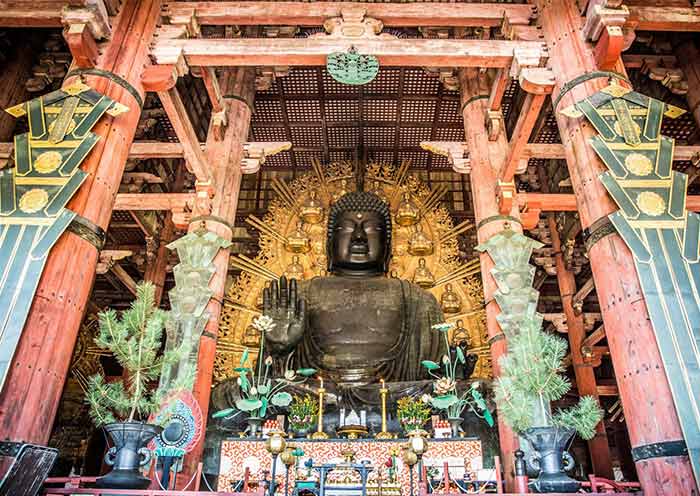
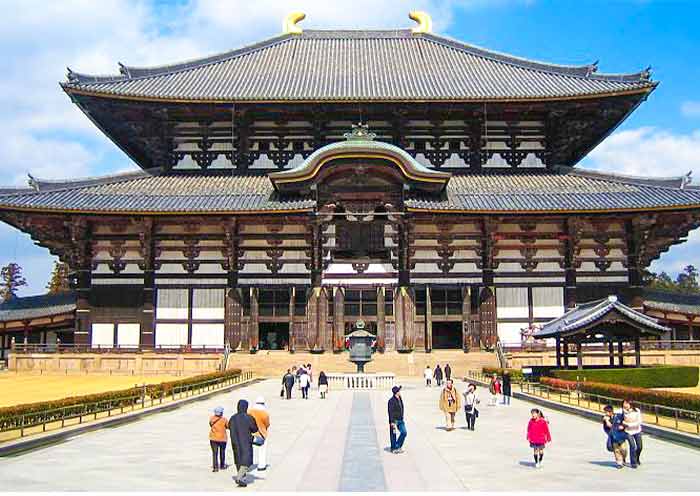
Todaiji Temple Famous for:
- Great Buddha Statue, Largest Bronze Statue in the world
- Adorable Deer Roaming Free
Todaiji Temple (東大寺) is a historic Buddhist temple located in Nara, Japan's very first capital, and stands as a symbol of the city's rich cultural and historical significance. Founded in the early 8th century, Todaiji is renowned for housing the Great Buddha (Daibutsu), a colossal bronze statue of Vairocana Buddha, which epitomizes ancient Buddhist culture and art.
The temple's Great Buddha Hall (Daibutsuden) is one of the largest wooden structures in the world and provides a striking backdrop for this awe-inspiring statue. The temple complex is a key representation of Nara's ancient heritage and Buddhist traditions.
One of the most unique and popular experiences at Todaiji is visiting the "Great Buddha's nostril" pillar. This wooden column, which has a hole carved at its base the size of the Great Buddha's nostril, is a fascinating feature. According to local belief, those who can squeeze through the hole will receive a special blessing.
Top 7 Things to do in Do in Nara: Places to Visit & Nara Tourist Attractions
Todaiji Temple's expansive grounds cover much of northern Nara Park, where visitors can encounter the famous Nara deer roaming freely. Feeding these deer with shika senbei (deer crackers) adds a delightful and interactive element to the visit, making Todaiji Temple a memorable destination that combines historical grandeur with engaging experiences in nature.
Kasuga Taisha Shrine (春日大社, Nara): Principal shrine of the Fujiwara clan in Japan

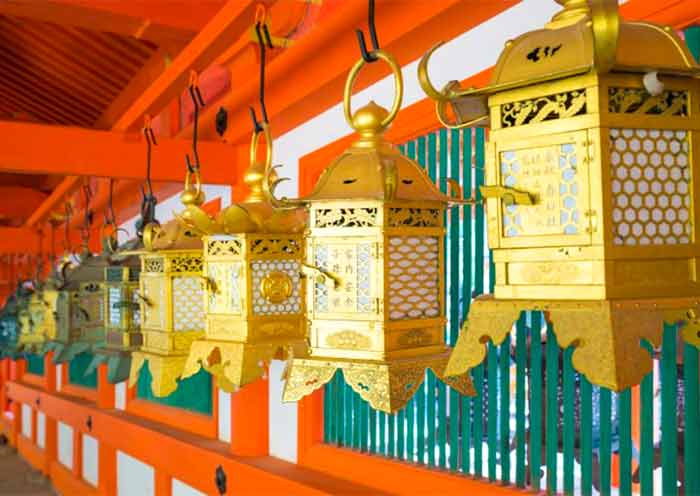
Kasuga Taisha Shrine Famous for:
- Closely Linked to Fujiwara clan
- Lantern Pathways
Kasuga Taisha Shrine (春日大社) is a historic Shinto shrine located in Nara, Japan, widely known mostly for its cultural and historical significance. Established in 768 AD, the shrine is dedicated to the deity Futsunushi no Mikoto, who is revered as the protector of the city of Nara. Kasuga Taisha holds a prominent place in Japanese history, being closely linked to the influential Fujiwara clan, Japan's most powerful family during the Nara and Heian periods.
The Kasuga Taisha shrine is renowned for its stunning array of lanterns, with over 1,000 bronze and stone lanterns lining the pathways and shrine grounds. These lanterns are especially magical when lit during the biannual Lantern Festivals, held in February and August, casting a warm, enchanting glow over the shrine's serene landscape.
When visiting the shrine you can also explore the Kasuga Taisha Museum, located near the main complex. The museum houses an impressive collection of relics and artifacts related to the shrine's history, offering insights into Kasuga Taisha Shrine's cultural heritage.
How to Get to Nara from Kyoto 2025
Additionally, the shrine hosts various festivals throughout the year, including the vibrant Kasuga Matsuri, which celebrates the shrine's traditions and features traditional performances and rituals. Exploring Kasuga Taisha provides a deep dive into Japan's rich historical tapestry and the spiritual heart of Nara.
Nikko Toshogu Shrine (日光東照宮, Nikko): Shrine Honoring the "Shining Light of the East"
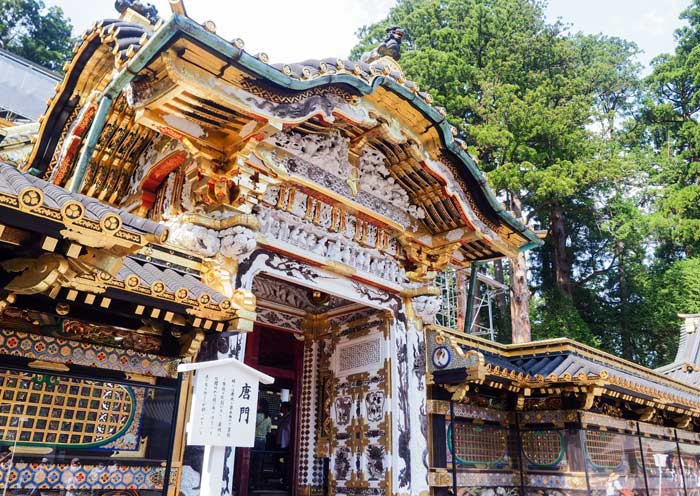
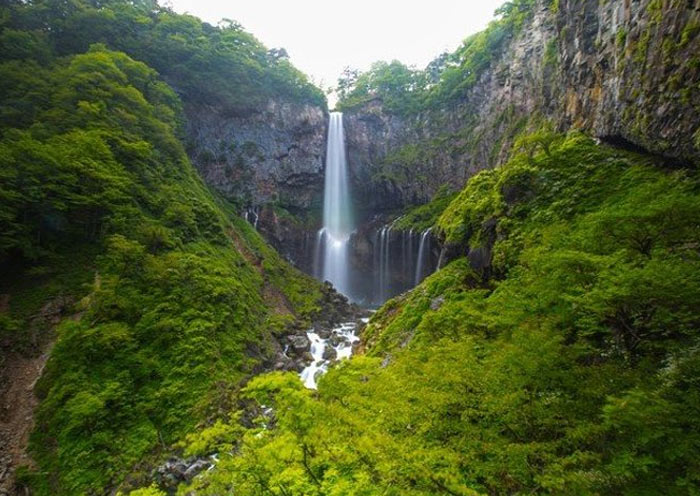
Nikko Toshogu Shrine Famous for:
- Tribute to Japan's unifier
- Shinto and Buddhist Elements Co-exist
Nikko Toshogu Shrine (日光東照宮) is a renowned Shinto shrine located in Nikko, Tochigi Prefecture, Japan. It serves as a magnificent memorial to Tokugawa Ieyasu, a tribute to Japan's unifier, the founder of the Tokugawa Shogunate, which ruled Japan for over 250 years. Spiritually wise the Shrine is dedicated to Ieyasu, who is revered as the "Great Deity of the East Shining Light." The Nikko Toshogu Shrine is a famous symbol of Japan's feudal era and its powerful shogunate.
The shrine's cultural and historical importance is reflected in its grand architecture and intricate carvings, which blend both Shinto and Buddhist elements, which are rare to find in other famous temples and shrine in Japan. The elaborate and ornate decorations, including the famous Yomeimon Gate, are highlights of Nikko Toshogu and exemplify the artistry and craftsmanship of the period.
When visiting the Nikko shrine you would have the chance to be amazed by the legacy of Tokugawa Ieyasu at the Nikko Toshogu Museum, a modern facility that showcases a fascinating collection of the shogun's personal artifacts. The museum features items such as armor, swords, and letters written by Ieyasu, offering a glimpse into the life and times of one of Japan's most influential historical figures.
Exploring Nikko Toshogu Shrine and its surroundings provides a profound connection to Japan's rich historical and cultural heritage, making it a must-visit shrine for history enthusiasts and travelers alike.
Meiji Jingu Shrine (明治神宮, Tokyo): Tribute to Emperor Meiji & Famous Symbol of Japan's Modernization
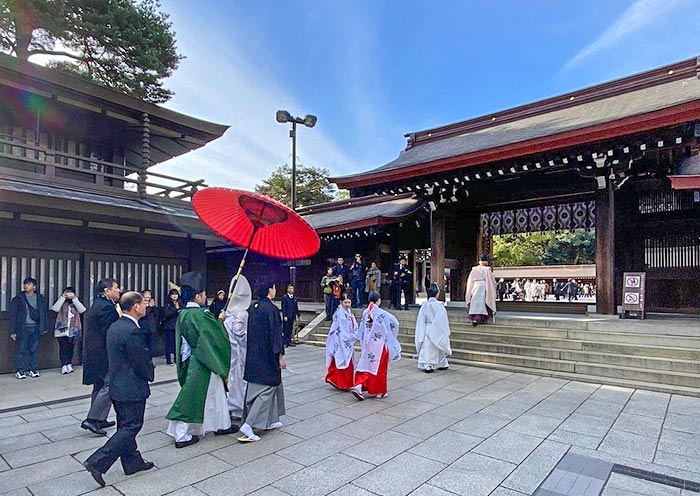
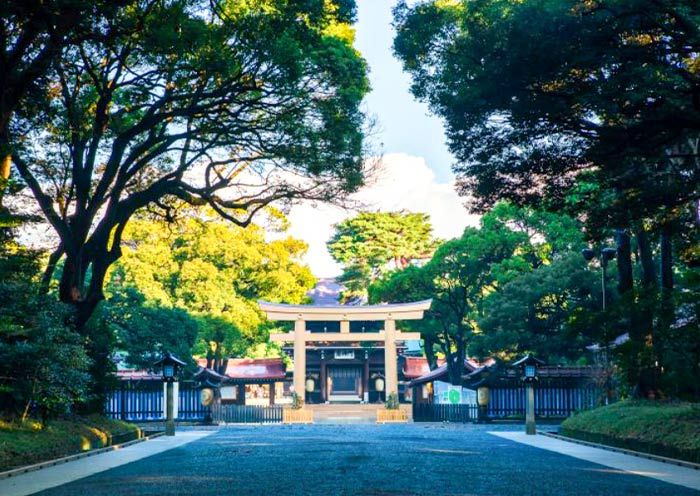
Meiji Jingu Shrine Famous for:
- Dedicated to Emperor
- Renowned Symbol of Japan's Modernization
Meiji Jingu Shrine (明治神宮) is a prominent Shinto shrine located in the heart of Tokyo, nestled within a lush forested area near Harajuku. Dedicated to Emperor Meiji and Empress Shoken, the shrine symbolizes the Meiji Restoration, a pivotal period that transformed Japan into a modern state and reshaped its society. That's why Meiji Jingu Shrine is so famous among tourists and local Japanese alike.
As a site of cultural and historical significance, Meiji Jingu Shrine is an enduring monument to Japan's modernization and the lasting impact of Emperor Meiji's reign. The shrine is renowned for its serene atmosphere (though can be crowded in high season because it's free to entry and easily accessible) and beautiful forested grounds, providing a peaceful retreat from the bustling city.
A highlight for visitors is the Meiji Jingu Museum, which houses a fascinating collection of treasures related to the emperor and empress. The museum features personal belongings of the imperial couple, including the carriage used by Emperor Meiji during the formal declaration of the Meiji Constitution in 1889.
If you visit the Meiji Jingu Shrine it would be a great experience to engage in traditional Shinto activities, such as making offerings at the main hall, purchasing charms and amulets for good fortune, or writing wishes on ema (wooden plaques). There is also a chance that you could see couples married in traditional Japanese ceromony. During the New Year, Meiji Jingu Shrine becomes a vibrant center for "hatsumode," the first shrine visit of the year, attracting over three million people who come to pray for good fortune and health.
Yasaka Shrine (八坂神社, Kyoto): Where Famous Gion Festival Originated
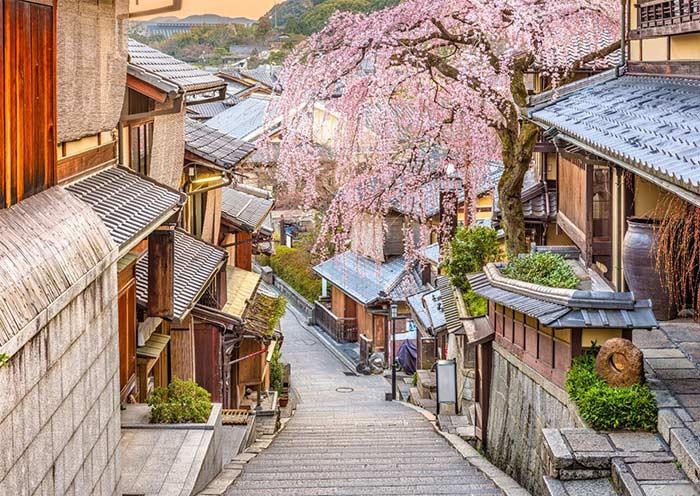
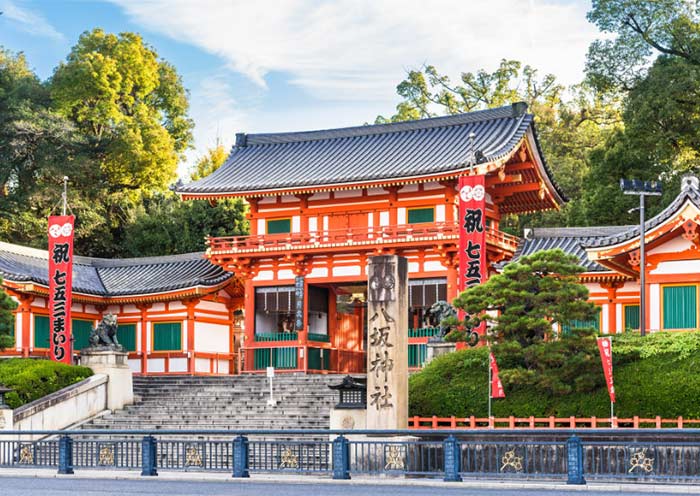
Yasaka Shrine Famous for:
- Gion Matsuri Festival, One of the Largest Celebration
Yasaka Shrine (八坂神社, Yasaka Jinja), also known as Gion Shrine, is a famous Shinto shrine located in the Gion district of Kyoto. Situated at the eastern end of Shijo Street, near the bustling Gion area, the shrine is dedicated to the deity Susanoo-no-Mikoto, the god of storms and seas, along with his consort, Kushinadahime, and their children.
Even if you haven't heard of the Yasaka Shrine, the famous festival sights of Gion Matsuri must look familiar for most people who love to explore Japanese culture.
Yasaka Shrine is renowned for its architectural beauty and its significant role in the Gion Matsuri, one of Japan's most famous and oldest festivals, held every July. The Gion Matsuri, which originated as a purification ritual to ward off epidemics, has evolved into a grand celebration with parades, floats, and various cultural events, attracting visitors from all over the world.
The shrine is also a popular destination during cherry blossom season, when the surrounding Maruyama Park comes alive with blooming sakura trees. Whether during the festive summer or the tranquil spring, Yasaka Shrine offers a blend of cultural significance and architectural marvels, making it a must-visit site in Kyoto.
Famous Japanese Temples & Shrines to Visit for Architectural Marvels
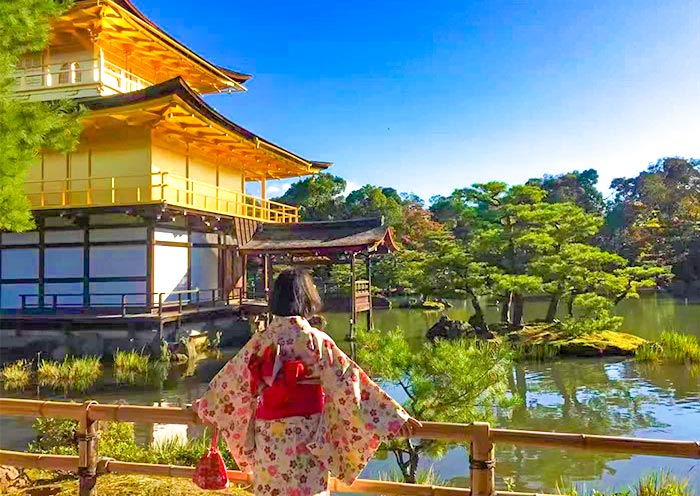
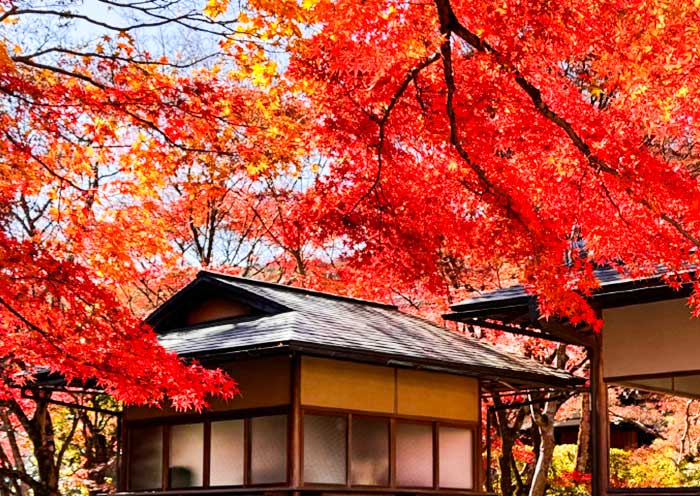
Japan's temples and shrines are celebrated for their stunning architectural marvels, blending intricate craftsmanship with cultural significance. The craftsmanship infused into the construction of these famous temples and shrines is most remarkable.
Here are some of the most iconic Temples and shrines in Japan: Kinkaku-ji Temple (Golden Pavilion) dazzles with its golden facade and multi-layered design; while Byodoin Temple in Uji features the iconic Phoenix Hall; Ryoan-ji Temple is renowned for its minimalist rock garden, a pinnacle of Zen design; Saihoji Temple (Kokedera), famous for its lush moss garden, an exceptional integration of nature and architecture. Fushimi Inari-taisha Shrine impresses with its thousands of vermilion torii gates creating a mesmerizing passage through the forest.
| Name | Specific Travel Highlights | Location |
|---|---|---|
| Kinkaku-ji | Golden pavilion, depicted in Yukio Mishima's novel The Temple of the Golden Pavilion. | Kyoto |
| Byodoin Temple | Famous Phoenix Hall, featured on the ten yen coin. | Uji, Kyoto |
| Ryōan-ji | Renowned Zen rock garden; minimalist design | Kyoto |
| Saihōji (Kokedera) | Expansive moss garden; visitors participate in Buddhist practices. | Kyoto |
| Kifune Shrine | Distinguished structure connected to water; famous kawadoko dining platforms, "boat stone." | Kyoto |
Kinkaku-ji Temple (金閣寺, Kyoto): Made More Famous By Yukio Mishima's Novel
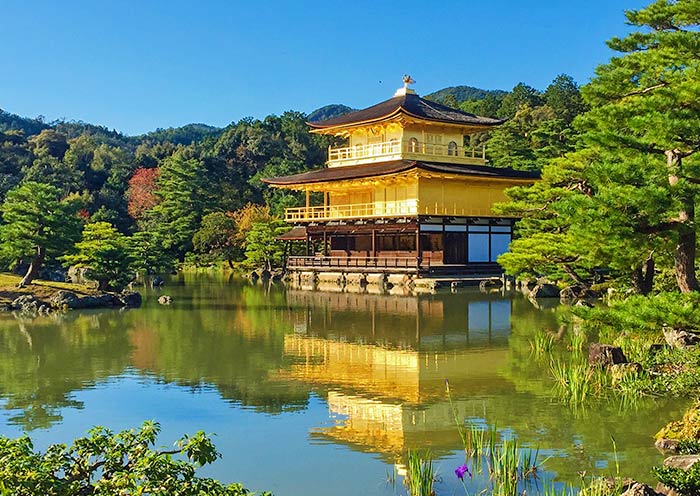
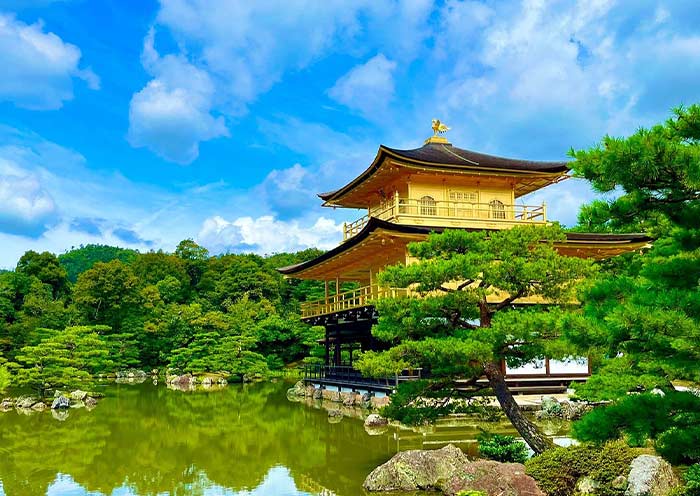
Kinkaku Ji Temple Famous for:
- Building Covered in Gold
- The Temple of the Golden Pavilion, Yukio Mishima's novel
Kinkaku-ji Temple (金閣寺), also known as the Golden Pavilion, is a magnificent Zen Buddhist temple located in Kyoto, Japan. This architectural marvel, originally constructed in 1397 as part of the retirement complex of shogun Ashikaga Yoshimitsu, is the only remaining structure from that period.
The Kinkaku-ji Temple is celebrated not only for its historical significance and exquisite architecture but also for its association with Yukio Mishima's novel The Temple of the Golden Pavilion, which explores themes of beauty, obsession, and destruction, and has made the temple even more famous over the years.
Kinkaku-ji temple is an iconic representation of Muromachi-period architecture, with the top two floors entirely covered in gold leaf, creating a stunning contrast with its natural surroundings. The pavilion is set against a serene pond, which beautifully reflects its golden facade, enhancing the temple's majestic presence.
The architectural design of Kinkaku-ji showcases three distinct styles. The first floor, built in the Shinden style typical of Heian Period palace buildings, features natural wood pillars and white plaster walls, offering a subtle elegance. The second floor, in the Bukke style used for samurai residences, is entirely covered in gold leaf, emphasizing the era's grandeur. The third floor, designed as a Chinese Zen Hall, is gilded inside and out, and crowned with a golden phoenix.
At this most famous temple in Japan visitors can explore the meticulously landscaped gardens, admire the pavilion's reflection in the tranquil pond, and gain deeper insights into the cultural impact of this iconic structure, making it an unforgettable experience.
Byodoin Temple (平等院, Uji): Golden Phoenix Hall, Architecture Reflecting Land Buddhism

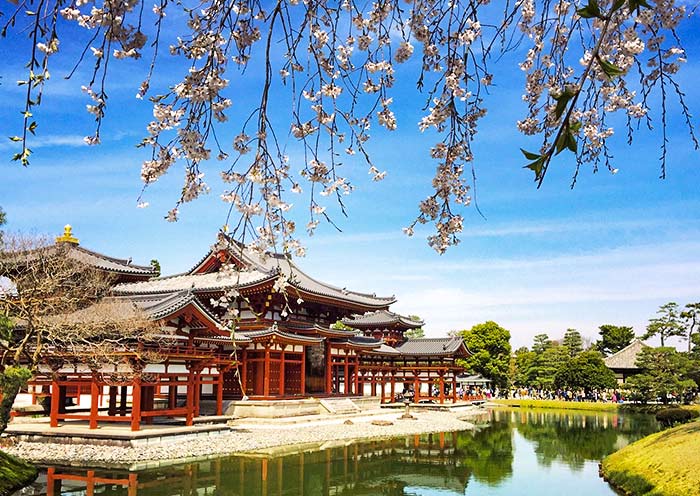
Byodoin Temple Famous for:
- The Burned Phoenix Hall
- Garden Reflecting f Pure Land Buddhism
Byodoin Temple (平等院), located in Uji, Kyoto Prefecture, is one of Japan's most celebrated architectural marvels. Originally constructed in 998 as a villa for a powerful aristocrat, it was later converted into a temple by his son. The temple is dedicated to the Amida Buddha, representing the Buddhist concept of the Pure Land, which originated from China.
The most famous structure within Byodoin is the Phoenix Hall, or Hoodo (鳳凰堂), an exquisite example of Heian-period architecture and Pure Land (Jodo) design. Built in 1053, the Phoenix Hall is named for its unique shape, which resembles a bird in flight, and the two phoenix statues perched on its roof. This iconic building is so significant that it is featured on the back of the Japanese ten yen coin.
Despite the temple's buildings being lost to fires and other calamities over the centuries, the Phoenix Hall miraculously survived, symbolizing the resilience and rebirth of the phoenix.
Visitors to Byodoin can explore the serene gardens, reflecting the harmonious principles of Pure Land Buddhism, and admire the Hall's graceful architecture, which seems to float above the pond in front of it. The temple also houses a museum where visitors can view national treasures, including statues, paintings, and artifacts related to the site's rich history.
Ryōan Ji Temple (龍安寺, Kyoto): Most Famous Zen Temple in Japan for Profound Reflection
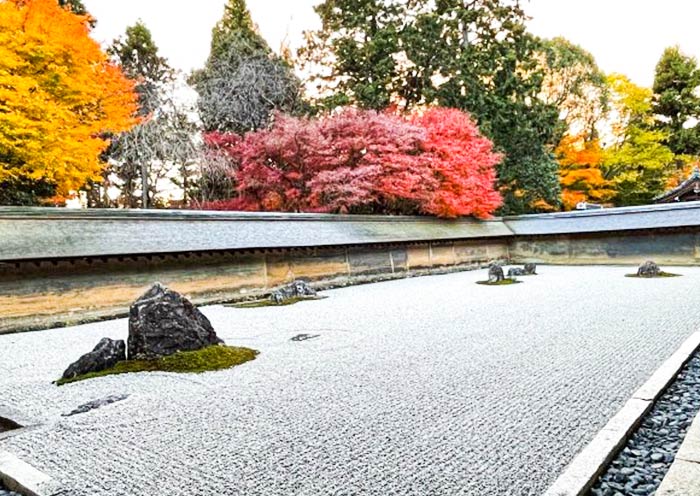
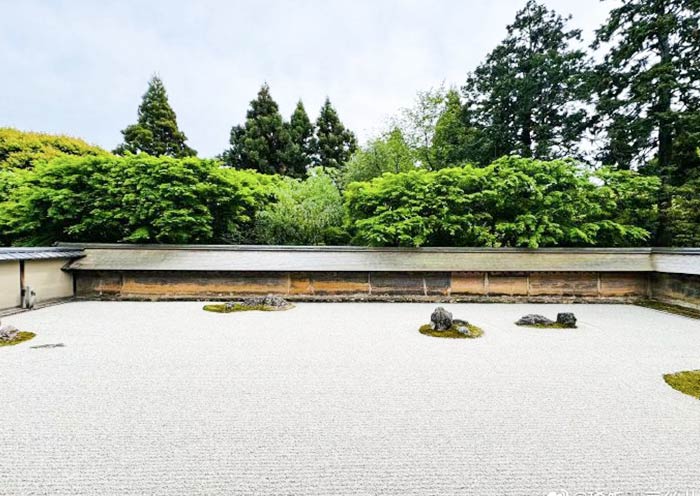
Ryoan Ji Temple Famous for:
- Most Famous Zen Garden Designed with Minimalist Style
Ryoan-ji Temple (龍安寺), located in the northwest part of Kyoto, is a Zen temple renowned for its iconic rock garden, a masterpiece of minimalist Japanese design. The temple, originally a villa, was converted into a Zen temple in 1450 and is dedicated to the practice of Zen Buddhism, emphasizing meditation and simplicity.
The highlight of Ryoan-ji Temple is its famous rock garden, considered the pinnacle of Japanese Zen gardens. This serene space consists of a rectangular plot of white pebbles, meticulously raked daily, surrounded by low earthen walls.
Fifteen rocks of varying sizes are artfully arranged in small groups on patches of moss, creating a landscape that embodies simplicity and tranquility. An intriguing aspect of the garden's design is that from any vantage point, at least one of the rocks is always hidden from view, symbolizing the incompleteness of human understanding and the importance of perspective in Zen thought.
However, the concept of this famous Zen garden is open to interpretation, see it on site you might have your own reflection.
Kyoto Temples & Shrines: 10 Famous Temples & Shrines in Kyoto (2025)
Visitors to Ryoan-ji Temple can sit on the veranda overlooking the rock garden, engaging in quiet reflection and meditation. The temple grounds also feature a beautiful pond and a teahouse, allowing for a peaceful retreat amidst nature and the timeless elegance of Japanese architecture.
Kifune Shrine (貴船神社, Kyoto): Where Goddess' Boat was Buried
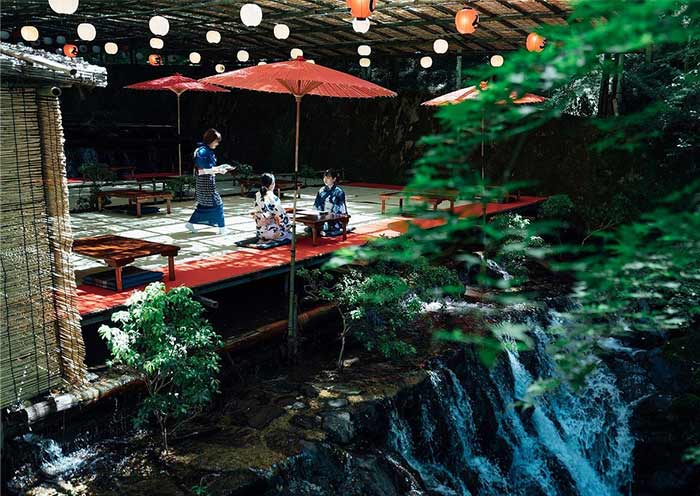
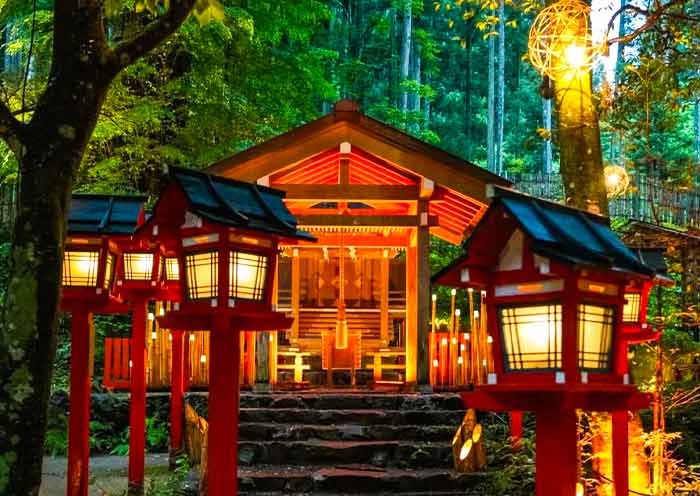
Kifune Shrine Famous for:
- "Kawadoko" dining over water
- Matchmaking Rituals
Kifune Shrine (貴船神社, Kifune Jinja) is a celebrated Shinto shrine nestled in the picturesque mountains of Kyoto's northern outskirts. Dedicated to the deity Takaokami-no-Kami, the god of water, rain, and agriculture, Kifune Shrine has long been associated with the elements and is particularly known for its connection to water. The shrine is a spiritual haven, where worshipers come to pray for rain, safe travels by sea, and successful marriages.
Architecturally, Kifune Shrine is unique and harmonizes beautifully with its natural surroundings. The approach to the shrine is marked by stone lanterns lining a steep flight of steps, leading to the main hall, which is elegantly integrated into the forested landscape. The shrine's tranquil setting beside the Kifune River enhances its spiritual ambiance.
A highlight of the shrine complex is Okunomiya, the inner sanctum and original site of Kifune Shrine. The Kifune Shrine is home to the "boat stone," a large rock said to be where the goddess' yellow boat is buried, adding a layer of mystical allure to the site.
One of the most distinctive and famous experiences at Kifune Shrine is the tradition of "kawadoko" dining, offered from June to September. Local restaurants build platforms over the river, allowing visitors to enjoy a meal while listening to the soothing sounds of water flowing beneath them. This practice provides a refreshing escape from the summer heat and is a favorite among both locals and tourists.
Must Try Food in Japan: 20 Unique Japan Food & Cuisine in Tokyo, Osaka, Kyoto.. 2025
Kifune Shrine is also famed for its matchmaking rituals, where visitors seek blessings for love and relationships. The combination of architectural beauty, natural serenity, and cultural traditions makes Kifune Shrine a truly special destination in Kyoto.
Saihoji (Kokedera) Temple: Intricately Designed Moss Garden, Famous yet Serene Ambiance

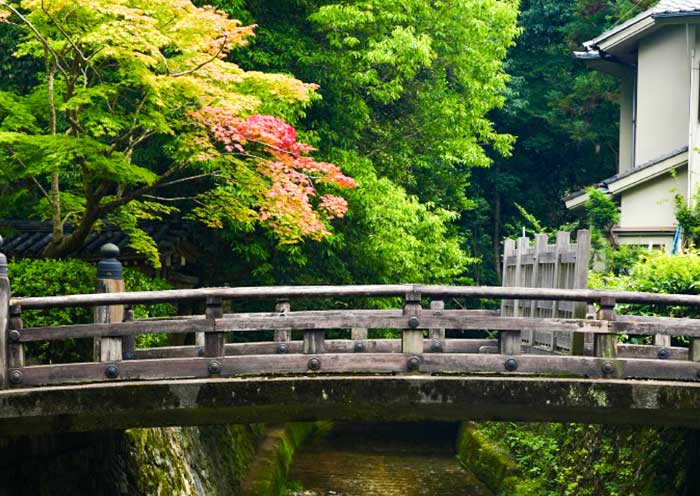
Saihoji Temple Famous:
- 120 Kinds of Moss, Classic Japanese Aesthetics
- Visitors to participate in copying of Buddhist scriptures
- Most Serene Ambiance
Saihoji Temple, more commonly known as Kokedera (苔寺), is a famous Zen Buddhist temple located in the western outskirts of Kyoto. The temple is dedicated to Amitabha Buddha and is famous for its breathtaking moss garden, which is considered a masterpiece of Japanese garden design.
The garden is believed to contain approximately 120 different varieties of moss, creating a serene, otherworldly landscape that changes subtly with the seasons.
The garden at Kokedera is a prime example of a Zen garden, designed to evoke a sense of peace and contemplation. The garden's layout is centered around a tranquil pond shaped like the Chinese character for "heart" or "mind," with moss-covered stones and carefully placed trees surrounding it. This design has greatly influenced Japanese garden aesthetics and has inspired countless garden designers over the centuries in Japan.
Though renowned the garden is not as crowded as other most famous temples and shrines in Japan. Visitors to Kokedera Temple are not only invited to stroll through this lush, moss-covered paradise but are also asked to participate in traditional Buddhist practices. Each visitor contributes to the observances of kito (chanting of sutras) and shakyo (copying of Buddhist scriptures). This combination of natural beauty and spiritual engagement makes a visit to Kokedera both a visual and meditative journey, offering a rare glimpse into the serene world of Zen Buddhism.
How to Plan Your Ultimate Japan Trip: 9 to 11 Days to Visit Famous Temples & Shrines in Japan
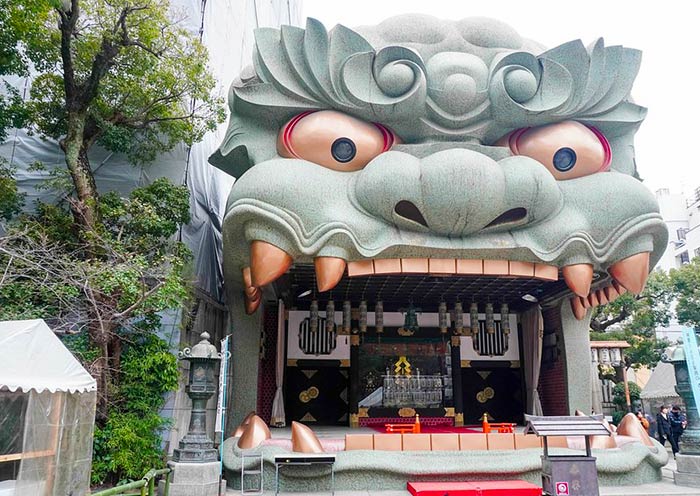
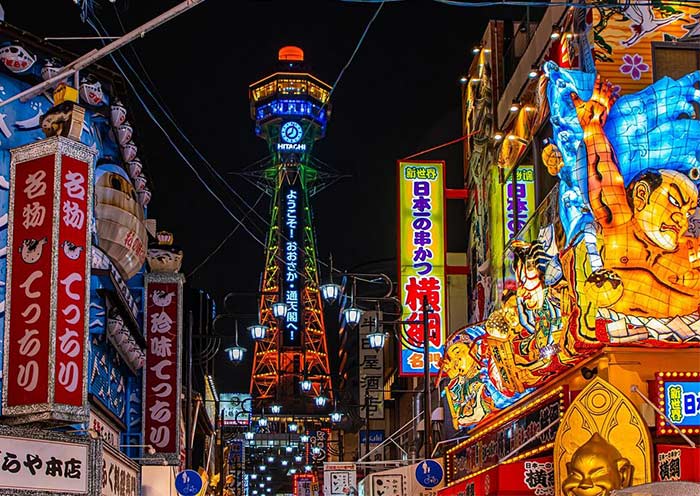
Osaka (2-3 days): Start your adventure in Osaka. Discover Osaka Castle and the Ukiyo-e Museum in the morning. In the afternoon, dive into a street food tour of Shinsaibashi, Dotonbori, and Namba, and explore Namba Yasaka Shrine, Namba New World, and the exterior of Tsutenkaku Tower.
Osaka Optional: Visit the Osaka Aquarium Kaiyukan, or walk into the Nintendo World, mingle with Minions at Universal Studios Japan.
Top Things to Do in Osaka: 11 Best Osaka Attractions & What to See
Hiroshima (1 day): Take a day trip from Osaka to Hiroshima. Travel by Shinkansen and visit the Hiroshima Peace Memorial Park, Peace Memorial Museum, and Atomic Bomb Dome. If time permits, take a boat to Miyajima Island to see Itsukushima Shrine. A 10-hour guided tour will ensure you don't miss any highlights.
Top 7 Things to do in Do in Nara: Places to Visit & Nara Tourist Attractions
Nara and Uji (1 day): On your way to Kyoto, explore Nara's Todai-ji Temple, Kasuga Taisha Shrine, and Nara Park. Then head to Uji to experience Matcha Street, Byodo-in Temple, and Uji Bridge. Spend the night in Kyoto with a 10-hour guided tour and driver.
Kyoto (3-4 days): Spend 3 to 4 days soaking in Kyoto's rich heritage. Start with Fushimi Inari Shrine, Kiyomizu-dera Temple, Ninenzaka & Sannen-zaka, Yasaka Shrine, and Gion & Hanamikoji.
Kyoto Optional: Experience a traditional Kimono dressing, or attend a geisha performance. Take a day to visit Kinkaku-ji Temple, Nijō Castle, and the Arashiyama area, including Sagano Scenic Railway, Bamboo Forest, Tenryu-ji Temple, and Togetsukyo Bridge.
Top 10 Things to Do in Kyoto | Kyoto Destinations & Must-See (for First Timers)
Tokyo (2-3 days): Explore Tokyo for 2 to 3 days. Begin with Meiji Jingu Shrine and Shibuya Crossing, then visit Sensō-ji Temple, Nakamise Shopping Street, and Tokyo Skytree.
Tokyo Optional: Explore Akihabara's anime cafés, visit Tsukiji Market for sushi, or enjoy the Odaiba waterfront area with attractions like teamLab Borderless. For a unique experience, visit the Robot Restaurant or catch a show at Kabukiza Theatre. Enjoy free time to explore the city further.
Tokyo Tourist Attractions | Things to Do & Places to Visit in Tokyo
The Japan Itinerary serves as a general guideline only and to curate a personalized Japan travel plan simply Contact your travel expert at Asia Odyssey Travel!

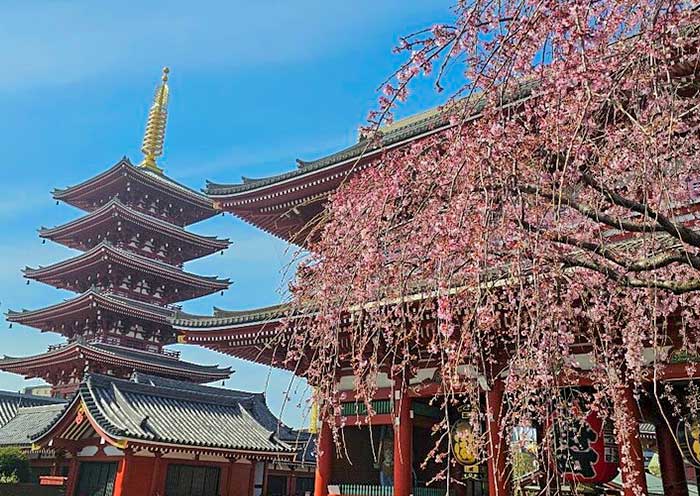
Discover Japan with Your Local Guide - Asia Odyssey Travel
Explore Japan with Asia Odyssey Travel! We are a local travel company with an office in Tokyo. We are here to help you enjoy the best of Japan. We offer simple, fun, and real local tours.
Our Japan Tours at a Glance:
✅ Japan Tours: 60+ Best Tour Packages
✅ Japan Group Tours: 6+ great value trips, including cherry blossoms & classical routes.
✅ Top Japan Destinations: Tokyo · Kyoto · Osaka · Hakone · Mt Fuji · Nara · Hiroshima · Hokkaido
✅ Theme Tours: Family Tours · Cherry Blossom Tours · Autumn Tours · Golf Tours
Helpful Guides for Your Japan Trip:
Japan Travel Guide & Travel FAQs: All you need to know before you go.
Useful Advice: How to Plan · Best Time to Visit · Cherry Blossom · Things to Do · Beautiful Places · Temples · Food · Maps · Rainy Season
Contact us now and start planning your dream Japan tour.
